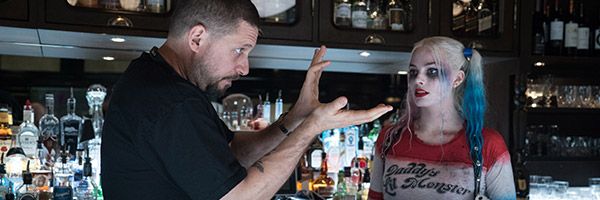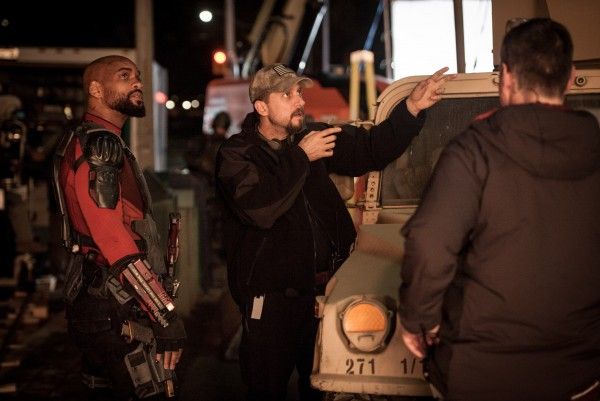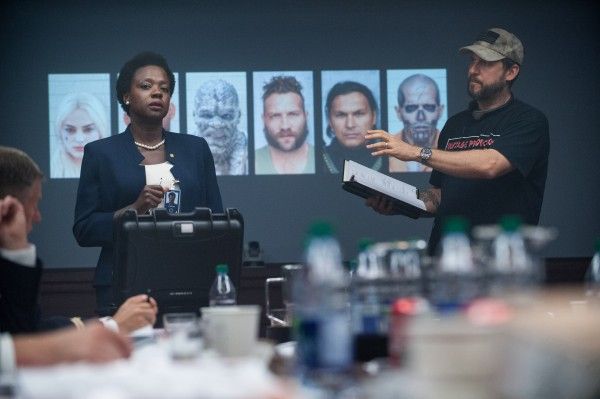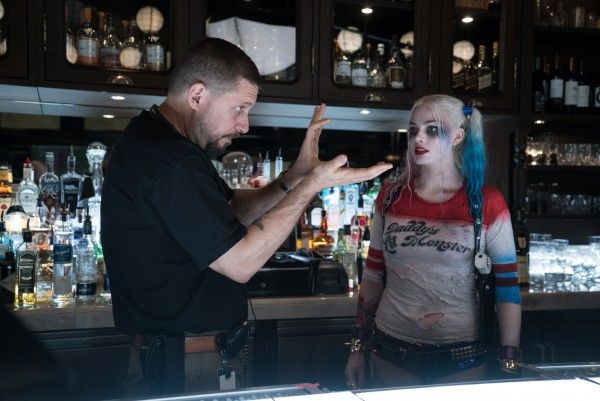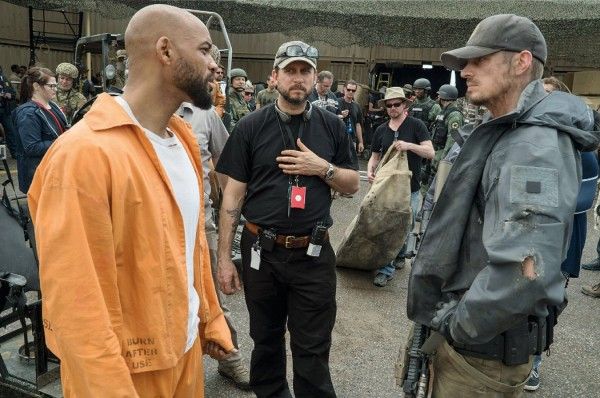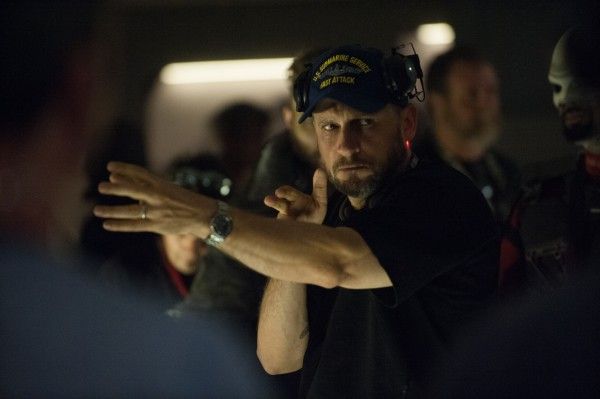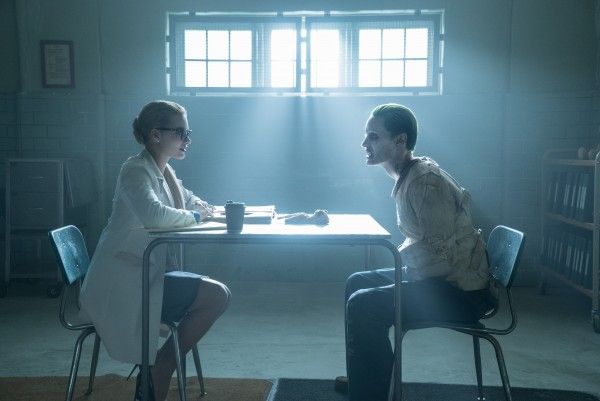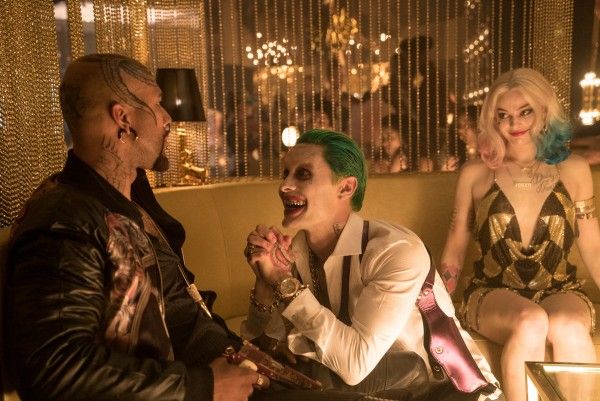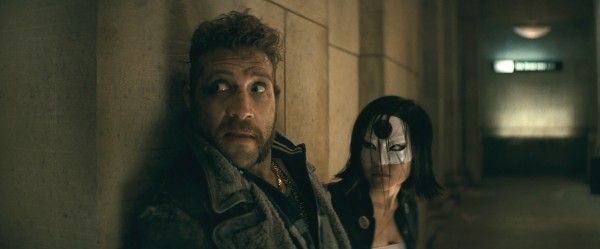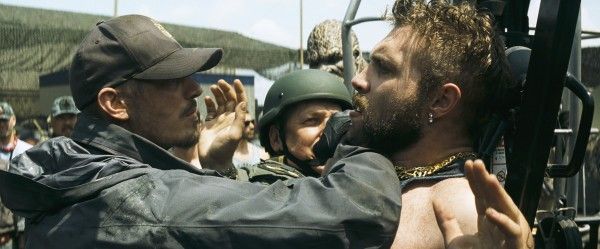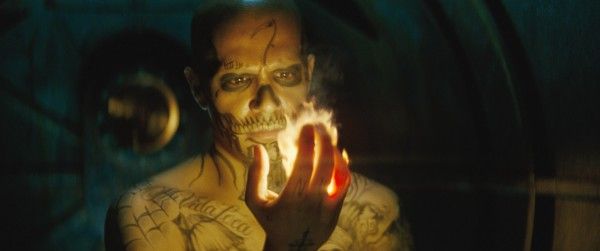[complextv contentid="1hbGQ3NTE6sO8QGn41R37GLsmt90RhzA" sitename="collider" playerid="26aa5f02d93f4c05a4546f6d5ecb59b7" adsetid="67a3ff9d3a842ae818bb9de1badc5b0" width="600" height="360" keywords=""]
Warning: Spoilers for Suicide Squad follow. If you haven’t seen the movie, turn back now.
Now that Suicide Squad is playing in theaters around the world, it’s time to post my full interview with David Ayer that was done at the New York City press junket a few days before the film came out. The reason I’ve waited until now to post the conversation is we talked about spoilers in the film – specifically about the ending and the mid-credits scene. So if you haven’t yet seen the film, you might want to wait to read this.
During the interview Ayer talked about the experience of making his biggest film to date, what he learned from friends and family screenings, deleted scenes, if we might get any Joker (Jared Leto) and Harley Quinn (Margot Robbie) cut scenes on the Blu-ray, the PG-13 rating and if they ever thought about going with an R, if he’d considered a more adult rating on a future comic book movie, The Flash cameo, the mid-credits scene with Amanda Waller (Viola Davis) and Bruce Wayne (Ben Affleck), ending with Joker and Harley Quinn getting away, and a lot more. Check out what he had to say below.
Collider: To start things off, I’m very curious, this is the biggest film you’ve made…
DAVID AYER: Yes.
How did this whole journey compare to what you thought you were gonna get? When you signed on you were like, “This could be a big movie” but it’s turned into…
AYER: A big movie.
A big movie.
AYER: [Laughs] Yes.
How does this whole thing compare to what you thought going in?
AYER: We thought it was gonna be an uphill battle to educate people on who these characters are and kind of what this world is, and it was like everybody just seemed to get it first bounce. It’s scary, the worst thing is the flip side where nobody cares about your movie, but right now it’s –I made it for the fans and I want them to like it, I want people to feel like they get their money’s worth at the theater, I want them to like the movie. That’s it, that’s all it is.
What did you learn from friends and family screenings and test screenings that impacted the finished film?
AYER: [Laughs]. As a filmmaker, the filmmaking team, and you’re a writer and you’re a director and you write this script, you have watched this film again and again and again in the editing room, you know what you’ve shot, you know everything you wrote, you’re saturated with knowledge about the movie and it can be hard to separate what you know from what you’re actually telling people on the screen, that’s what you learn from friends and family like, “Whoa, that didn’t land, that didn’t come across. Ok, we need to clarify that” or “People are confused here, this moves to slow” or “this moves to fast” so a lot of it is shifting pacing and time. The biggest lesson was that people like the movie, because you never know, you put it up and the movie could be broken and then, “Ok, what do we do now?” So there’s good news out of the screenings but at the same time it’s like a diagnostic tool.
Who did you invite to your first friends and family screening?
AYER: It was pretty significant, there was a couple of hundred people there and…
That’s friends and family screening?
AYER: Yeah. So it’s like friends of the post crew, friends of the producers, people I know, my family. So you get a lot of people there and you do cards and you ask questions and then you run a little statistical analysis on it to try and see what’s bumping on people. Sometimes people don’t understand if the ending worked, understand the characters, a lot of issues, like, “I can’t understand the dialogue” “Ok, good to know.”
That’s a pretty significant note.
AYER: Yeah.
You didn’t have a note like, “This is borderline Bane” did you?
AYER: No [Laughs].
How long was your first cut?
AYER: Define first cut.
Not the assembly, but the first time you put it together that you had a cut of the film and you were like, “This is pretty good.”
AYER: It’s funny because...let me say this, there’s three movies you make: There’s a movie you write, there’s a movie you shoot, and there’s the movie in post that you edit. When you put a cut together it’s about plateaus, so the first sort of plateau the movie got was just under 3 hours, I think it was 2:45 or something like that.
Was that a cut that you would’ve been ok with if people watched it?
AYER: No.
So that’s just like a lot of shit in it.
AYER: That’s a lot of shit, yeah. I think there’s a misunderstanding about filmmaking where you can somehow have this crystal ball and understand exactly how everything is going to together and assemble together. A scriptwriter types word on a page, a black and white page, and when you’re on set you’re dealing with shots and your dealing with dailies, and so you have a seven minute shot and maybe only ten seconds of that shot is gonna end up in the movie. And there’s infinite combinations, infinite knock-on effects, and it’s this strange alchemy that happens and things that you thought during the writing phase breaking your back trying to explain and needs three pages to explain it, you realize it works with just a look on camera in the assembly. So it’s always a moving target as you try and distil and condense down to the best movie, and this thing was a beast, we had over a million and a half feet of footage, with an ensemble movie, seven plus major characters that we have to introduce, a very complex story that is not your normal linear story and your introducing the audience to a whole new world, plus it just has my sort of sickness as a filmmaker in it, my vibe and attitude. So it just took a lot of work to find the movie, the movie was always there and even in the early cuts we knew we had something we knew it was going to work, but to get it there…wow.
A lot of fans are gonna look forward to seeing deleted scenes on the Blu-ray, because when you have Jared [Leto] as The Joker, when you have these characters that are very big to a lot of people...Are there 5-10 minutes of deleted scenes, what are you putting on the Blu-ray from the movie that you cut out?
AYER: We have a chunk, there’s definitely over 10 minutes of material on there. But this cut of a movie is my cut, there’s no sort of parallel universe version of the movie, there released movie is my cut. And that’s one of the toughest things about writing, shooting, and directing a film, is you end up with these orphans and you fucking love them and you think they’d be amazing scenes and do these amazing things but the film is a dictatorship [Laughs], not a democracy, and just because something’s cool and charismatic doesn’t mean it gets to survive in the final cut. The flow of the movie is the highest master.
Are there deleted scenes of Joker and Harley that will be on the Blu-ray?
AYER: …maybe.
[Laughs]. People have been waiting a long time to see Joker and Harley together on screen and also a lot of the other characters. What were the parameters specifically for Joker and Harley that you had to work in, or did Warner Brothers sort of say, “Hey go write your script and we’ll let you know if you’ve gone too far”?
AYER: It was kind of the latter, really from the beginning I was told, “Go make your movie”, Zack [Snyder] said it, the studio said it, “Make the movie you want to make.” And that’s why they brought me in, they know my viewpoint, they know I’m a filmmaker with my own angle on things and that was the fun of this, there’s not really another comic book movie like this. That being said, you’re a big ship in a formation of other ships traveling across the ocean, and that’s where Geoff Johns becomes priceless because he has such a command of the DC fiction universe and he’s able to help you steer the right course and make sure there’s no collisions two years from now.
Was is always going to be after Batman v Superman, or was there a time where this script or the movie was before Batman v Superman?
AYER: No, it was always after BvS, there was always a continuity, there are shared assets, we precede JLA, so there’s a lot of little bits that connect.
When I put I was talking to you on twitter, literally everyone was like, “Are you assuming this is a hit, is this a world you want to jump into?” Assuming it makes enough money that they want to play in this universe again, is this one of these films that you’d want to come back an work in this universe again, or do you feel like, “Wow this was a huge challenge, I’m good, I’ve made my comic book movie”?
AYER: You can’t assume that anything’s a hit, you can’t assume success. I want people to see it, I want them to like it. If they do, we this sort of crazy movie family and there’s a lot of love that this cast has for each other, these guys are lifelong friends now, and I got to be a part of that and it would be a hard thing to walk away from.
I definitely want to touch on the rating. After Deadpool and the R rating, was there ever a point where the studio or you were thinking, “Look at how much this made with an R rating, pushing the boundaries.” How did you guys feel about that?
AYER: This was always going to be a PG-13 from its inception. To me Deadpool is a bit of an outlier and I don’t know that that’s something you can model on, I honestly don’t know if that is an itch you can keep scratching with multiple projects, and I think that that’s also such a specific animal, and this thing was never intended to be R-rated so the material to do that didn’t exist and I found myself being my own sort of traffic cop on set just keeping, you know, “Alright guys let’s keep it family, we’re not gonna do that, chill out. Don’t say that, no, no. Put the blood away, we’re not gonna see it. Say the F-bomb, then do it again without the F-bomb.” It was a bit of an out-of-body experience after the movies I have made in the past, but at the same time we got the rating with no problem and I kind of like it, I liked the challenge of that and it’s almost like in the ‘50s and the ‘40s the writing was spectacular because you had to talk around things and you had to be smart about how you communicate to people, and I enjoyed that challenge.
If you were to play again in the DC universe, would you consider making an R-rated film?
AYER: I wouldn’t do these characters, it would have to be –Sure, but it would be a one-off thing in my mind. It’s honestly not that compelling to me, because I feel like I found my voice in this world and answered the question of “Can I even do this? Am I capable of making a movie like this?” I think I found my voice.
I want to jump into what I call “the spoiler section” which will not run until the movie comes out. Talk a little bit about how Flash got into the movie, was it always that Flash was gonna be in it, or was that part of the reshoots?
AYER: Flash was always in the movie, we just got lucky because JLA was happening and so they had the uniform, they had the assets, so we were able to get that photography.
When did you shoot the Flash sequence?
AYER: That was shot in London.
So Zack shot it?
AYER: Yeah.
Do you know when it was shot?
AYER: It was shot is post, we were in post, it wasn’t during our principal photography.
The mid-credit scene, how did that come about?
AYER: That was always in the original script, we shot that in Toronto with Ben [Affleck] up there during principal photography.
So that was done a while ago. That was always the intention?
AYER: It was in there, yeah.
Talk a little bit about writing that scene. Amanda Waller’s such a great character and seeing here opposite Bruce...
AYER: It’s two type A powerful people going at it which is great drama, it doesn’t get better than that. That was a lot of fun to shoot, Ben’s a ridiculously talented actor and Viola [Davis], forget it, she has insane depth and range; and so being able to direct the two of them that’s what I loved, that’s why I’m in this business, it’s scenes like that, that was a true pleasure.
The movie ends with Joker and Harley getting away, was that always the intention, was that always the way it was in the script since day one?
AYER: We shot that during the first week of photography.
Talk a little bit about writing that sequence and why you chose to end on that moment.
AYER: I don’t want to give stuff away but it’s that anything is possible, and that’s the thing, for as much control and commend Amanda Waller has over these guys, at the end of the day they’re supervillains and they’re gonna do supervillain stuff. Plus, the Joker/Harley relationship just seemed like the right button for the movie, it opens so many doors if another one of these were ever to turn up under a rock somewhere.
So let me ask you, have you written a word toward a sequel or another Suicide Squad film, have you actually written pen-to-paper o computer ink?
AYER: I don’t know, there may be a cocktail napkin with some scribbles on it somewhere, I don’t know [Laughs].
For more on Suicide Squad, click here for all our previous coverage.

